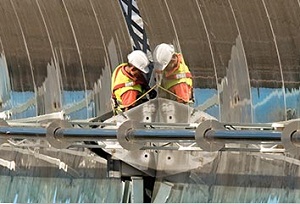U.S. solar market poised for growth
 With five of the most tumultuous months in solar history behind it, the United States market is poised for major growth.
With five of the most tumultuous months in solar history behind it, the United States market is poised for major growth.
That was the message Shayle Kann, managing director of the solar division of GTM Research, shared with several hundred solar industry representatives in his opening remarks at the Solar Power Generation USA conference in Las Vegas Tuesday.
The U.S. has installed about 5 to 7 percent of the world’s solar every year since 2005, Kann said.
While the U.S. market has been growing by leaps and bounds, so has the global market, which has kept the U.S. solidly in third, fourth and fifth places among nations around the globe installing solar.
“The U.S. has always been interested in solar,” Kann said. “But it certainly hasn’t been driving the solar market.”
That’s about to change as new solar business in countries like Germany, Italy and Spain reduce and eliminate their subsidies and development tapers off there.
“The global market is going to be slowing down a bit,” Kann said. “By contrast, the U.S. market is just getting started.”
While the U.S. market is a lot harder to enter because regulations make development slower, and each of the 50 states has a different set of policies, guidelines and subsidies, foreign investors are coming into the country ready to put in new solar farms and plants.
“Come 2015 or 2016, the U.S. market is going to be in first or second place, depending on what happens in China,” Kann said.
All of this growth will happen both in spite of and because of some of the major events that have marked the solar industry over the last five months, Kann said.
Some solar companies, like Evergreen Solar, folded and went under last year. Module prices have nosedived as a result of oversupply in the market as manufacturers ramped up production and European installations slowed.
The Blythe Solar project announced that it would switch from concentrated solar power to standard photovoltaic panels in August.
“That was a very negative sign for CSP’s competitiveness,” Kann said. “But it’s too early to sound the death knell for that technology.”
The biggest thing to happen this year, however, was the failure of Solyndra.
“We were blessed to have near universal approval of solar in this country,” Kann said. “Nearly everybody liked solar. Solyndra changed all of that.”
The company, which received a Department of Energy loan guarantee failed and drew attention to solar subsidies and negative political sentiment.
“My cab driver asked me about Solyndra,” Kann said. “Solyndra is not going to go away. It’s going to be an issue for the next year.”
Also, SolarWorld filed complaints with the Federal Trade Commission about Chinese solar panels, which could result in new import tariffs on Chinese-made solar panels, which has left U.S. developers guessing at what the best path for module acquisition will be.
With all of the tumultuousness in the market, it continues to grow, Kann said. And new developers he’s never heard of are showing up in line to develop projects across the country.



